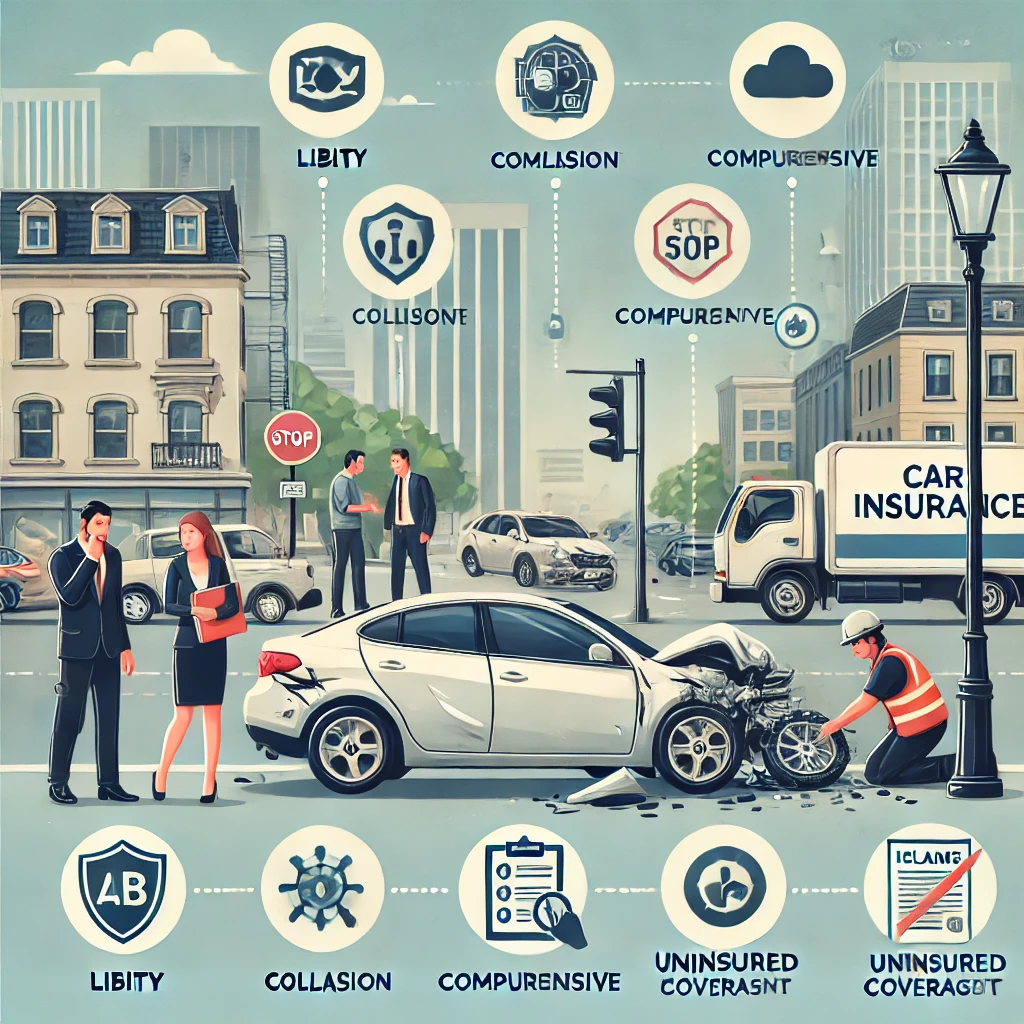Comprehensive Car Insurance Coverage: A Visual Breakdown

Why Car Insurance is Necessary
Car accidents are unpredictable, and the financial consequences can be devastating. Medical bills, vehicle repairs, legal fees, and liability for the other driver’s damages can quickly add up. Car insurance mitigates these costs by providing coverage in the event of an accident or other covered incidents. In most places, having at least basic insurance is mandatory, ensuring that drivers can cover the costs of accidents for which they are at fault.
Types of Car Insurance Coverage
- Liability Insurance: This is the minimum coverage required in most jurisdictions. Liability insurance covers two areas:
- Bodily Injury Liability: If you’re at fault in an accident, this covers medical expenses for injuries caused to other drivers, passengers, and pedestrians.
- Property Damage Liability: Covers damage to someone else’s property, such as their car, fences, or buildings.
- Collision Coverage: This optional coverage pays for repairs to your car after a collision, regardless of who is at fault. It’s particularly useful for newer or more expensive vehicles but can be less necessary for older, lower-value cars.
- Comprehensive Coverage: This protects your vehicle from non-collision incidents like theft, vandalism, natural disasters, or hitting an animal. Comprehensive coverage often pairs well with collision coverage for complete vehicle protection.
- Personal Injury Protection (PIP): Also known as “no-fault insurance,” PIP covers medical expenses, lost wages, and even funeral costs for you and your passengers, regardless of fault. It’s required in some states and optional in others.
- Uninsured/Underinsured Motorist Coverage: If you’re involved in an accident with a driver who has no insurance or insufficient coverage, this policy helps cover your medical expenses and damage to your vehicle.
Factors Affecting Car Insurance Premiums
Several factors influence how much you’ll pay for car insurance. Understanding these can help you manage your costs effectively:
- Age and Driving Experience: Younger and less experienced drivers generally face higher premiums because they are statistically more likely to be involved in accidents.
- Location: Urban areas typically have higher premiums due to the increased risk of accidents, theft, and vandalism.
- Driving Record: A clean driving record with no accidents or traffic violations will usually result in lower premiums, while a history of accidents or speeding tickets can increase rates significantly.
- Type of Vehicle: High-performance, luxury, or sports cars often cost more to insure due to their higher repair costs and increased likelihood of being involved in accidents.
- Credit Score: In many places, insurers use credit scores as a risk indicator. Drivers with higher credit scores often enjoy lower premiums.
- Annual Mileage: The more you drive, the more likely you are to be in an accident. Many insurers offer lower rates for low-mileage drivers.
How to Save on Car Insurance
Here are some strategies to help reduce your car insurance costs:
- Shop Around: Different insurers offer varying rates, so it pays to compare quotes from multiple companies. Don’t settle for the first policy you find.
- Bundle Policies: Many insurance companies offer discounts if you bundle multiple policies, such as car and home insurance.
- Increase Your Deductible: A higher deductible (the amount you pay out of pocket before your insurance kicks in) can lower your premium. Just be sure you can afford the deductible in the event of a claim.
- Take Advantage of Discounts: Insurers often provide discounts for safe driving, good student grades, installing safety features in your car, or completing a defensive driving course.
- Maintain a Good Credit Score: In areas where credit scores impact premiums, improving your credit score can help lower your rates.
- Reduce Coverage on Older Vehicles: If your car is older and has a lower market value, consider dropping collision or comprehensive coverage to save on premiums.
How to Choose the Right Policy
When choosing a car insurance policy, it’s essential to balance coverage and affordability. Here are some steps to guide you:
- Evaluate Your Needs: Consider factors such as the age and value of your vehicle, your driving habits, and your financial situation. A new or expensive car may warrant full coverage (collision and comprehensive), while an older vehicle may only need liability coverage.
- Understand the Legal Requirements: Make sure you meet the minimum insurance requirements in your area, but don’t limit yourself to the bare minimum if you can afford more comprehensive coverage.
- Check Insurer Reputation: Look for insurers with good customer reviews, reliable claims processes, and financial stability. You want to be sure your insurer will handle your claims efficiently and fairly.
- Review Deductibles and Limits: Choose a deductible that balances affordability with a reasonable level of risk. Also, ensure your coverage limits are high enough to protect your assets in case of a serious accident.